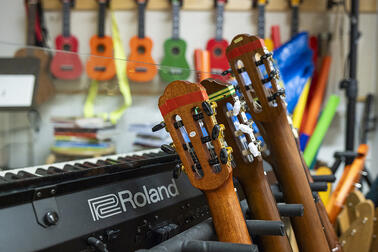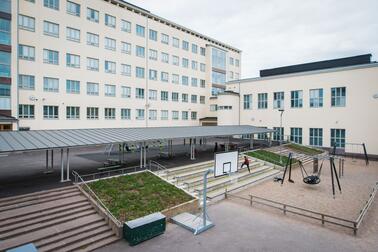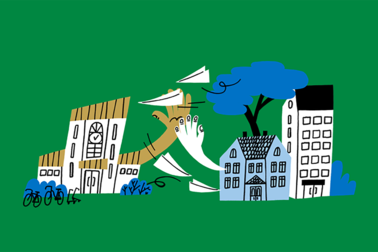
Itäkeskus Comprehensive School has one preparatory education class for pupils in grades 7–9. Last year a half of the pupils in the class were from Ukraine, now there are none. Two of them are from Somalia and the remaining 11 each from a different country, with Spanish, French, Arabic, Kurdish and Filipino as their mother tongues.
Preparatory education lasts one school year. A learning plan is first prepared for each pupil and their language skill level is assessed. Does the pupil know our letters or are they perhaps using other letters?
“Some of them have a fragmented school path behind them. The pupils come from a variety of backgrounds. Each student is different,” says principal Jutta-Riina Karhunen.
The teacher meets the guardians of each pupil, often accompanied by an interpreter. The school’s multilingual instructors are of great help, as they speak Somali, Arabic, Russian, Ukrainian and English.
Finnish skills must be taken into account
Language awareness plays an important role at Itäkeskus Comprehensive School. According to the school’s philosophy, the whole personnel are responsible for strengthening the pupils’ knowledge of Finnish.
“We have many pupils studying Finnish as a second language, also known as S2 pupils, who speak 30 different mother tongues. Teaching Finnish must be taken into account in all subjects and activities, such as teaching them how to prepare sweet rolls in home economics,” Karhunen says.

Marharyta, 15, and Davyd, 14, moved to Helsinki from Ukraine last year, due to the war. Marharyta feels that the Finnish school system is less stressful than the Ukrainian.
"Here, studying feels comfortable and unhurried."
Kai, 14, from the United States agrees with them. There was more schoolwork, homework and stress in the United States. Lorraine, 15, praises the teachers, as they help and treat pupils who have moved to Finland in the same way as they do other pupils. Teaching groups in her home country, the Philippines, are much bigger, with 30–40 pupils in the same class.
All four youngsters were studying in the preparatory education class last year and moved to mainstream education this autumn. Marharyta says she can speak simple sentences in Finnish as well as read and write. Kai says he understands basic sentences if the context is familiar.
Molecular blocks and pictures
Developer teacher Jenni-Pauliina Jokinen from the project Taitavasti tulevaisuuteen (“Skillfully towards the future”) supports the pupils at school. For example, she is responsible for considering how to bring out the pupil’s knowledge in different subjects even if their language skills are still inadequate.
“In chemistry, we have built molecular models using building blocks. If concepts are difficult, they are explained using other languages and pictures in addition to Finnish.”
The preparatory education class studies as a group, though some of the pupils quickly move to mainstream education to study mathematics, for example. This is important in order to make friends and hear Finnish.
Sometimes the teacher may feel inadequate if the student does not understand.
“During the preparatory year, the teacher only has to evaluate the learning of Finnish. Many of the pupils are good in mathematics, and the use of Google Translate during lessons is allowed,” Karhunen points out.
The pupils can use their mother tongue in situations where their knowledge of Finnish becomes an obstacle. They are also allowed to use English.

Learning affects identity
The purpose of the preparatory education class is to teach enough Finnish so that the following year, the pupil can attend mainstream education with others.
“I have to admit it that this is a very challenging task. At our school, almost all of the pupils go to a class a grade lower,” Karhunen says.
If the young person has knowledge and skills from lower grades in their home country, the situation is good. If they have not attended school or cannot read and write, it will be difficult to achieve sufficient language skills in one year.
According to the principal, learning Finnish and school skills would be easier if the duration of the preparatory education could be adjusted more flexibly.
"The pupil easily develops a negative identity if they constantly feel that they are not learning. They may also develop behavioural disorders if they constantly have to struggle."
Pupils agree.
“Another year would be good. You must know Finnish well in order to understand the content of teaching and it is difficult to get a good grade,” Marharyta feels.
Almost all young people who have just moved to Finland know English, which Karhunen thinks should be utilised. In her opinion, the opportunities for attending school in English could be increased in Helsinki.
“If we want quicker integration, there should be an opportunity to study a profession in English. After all, not everyone who moves here will end up staying in Finland.”
Flexible cooperation is a strength
The Taitavasti tulevaisuuteen project was launched last spring. There are developer teachers in nine schools in Helsinki strengthening the skills of lower secondary school pupils who are transitioning from preparatory to basic education and to create common practises for the transition.

Jokinen cooperates with the school’s special education teachers, S2 teachers, multilingual instructors and school counsellors, for example.
“Flexible cooperation between different professionals is our school’s strength. Nobody is left alone with any issues,” she says.
"Our personnel are highly solution-oriented and do not address things through problems", Karhunen praises.
A lot of different projects are arranged at the school, in which the pupils of the preparatory education class do things together with others. The school’s excursions teach young people to cope in their everyday life: use the metro, go shopping, visit the library as well as enjoy local natural areas.
“You should not be afraid to speak a new language!” the youngsters encourage other immigrants.
Jokinen plays an important role when the preparatory education class ends. She makes sure, together with the guidance counsellor and the multi-lingual instructor, that all essential information about the pupil is transferred forward.
“I am also an adult with whom the pupils are more familiar and whom they can turn to if they have a question or problem. Supporting the pupils depends very much on the situation.”
A respectful encounter is key
Building positive education and a strength-based operating culture has played an important role in the Itäkeskus Comprehensive School. When the teacher knows the pupils and their strengths, they also know how to support them.
Strength vocabulary and emotional and interaction skills are regularly practised together with the pupils. The school uses the Huomaa hyvä! (“See the good!”) material as an aid.
“Well-being stems from knowing how to be with others. We pay a lot of attention to friendship skills and social skills,” the rector says.
The school is relatively small: 420 pupils, of whom about 160 lower secondary school pupils. A small community brings safety.
“The teachers recognise the pupils by appearance, we greet each other in the corridors and it is easy to stop for a chat,” Jokinen says.

Karhunen mentions several times the importance of a respectful encounter for well-being.
“How adults at the school treat young people, directly correlates with how respectfully they treat adults. We have succeeded in this.”
Pupils from other schools also come to the preparatory education class at Itäkeskus Comprehensive School. After a year they typically move to their own local school, but not always. Many of last year’s pupils remained at Itäkeskus, as there were places for them. As a result, they did not have to start all over again at a new school.
Addressing hidden racism
The whole personnel of Itäkeskus Comprehensive School have completed training on an anti-racist approach to work.
“There is hidden racism in all schools. It shows in attitudes, facial expressions and elsewhere, and should be paid attention to,” Karhunen points out.
According to studies, Finland is one of the world’s most racist countries, and racism can be encountered on the streets, for example. However, Lorraine thinks that not all Finns are racists, especially not young people and not all adults.
“I was once at a marketplace when a lady yelled at me “Go back to China!” And yet I am not from there in the first place.”
It takes time and effort to get rid of structural racism. When a work or study environment is multicultural, thinking changes so that you no longer think of people in terms of their background.
“It is useful for everyone’s well-being that the children and young people arriving in Finland can cope with life. Our entire personnel agrees that we will do all we can to ensure that they succeed in their studies, get into working life and succeed in life,” Jutta-Riina Korhonen says.
Some of the children come from conflict areas. If they have seen terrible things - violence or war - in their life, it is difficult to imagine a different kind of future.
“Creating hope and fighting hopelessness is important. Instilling the mindset that things can get better and that you can become anything.”
Text: Nina Dale
Photos: Laura Oja
This article is part of a series that introduces Helsinki's actions to build a good future together, for each of us.
#education2030 #helsinkieducationfuturecompetences


